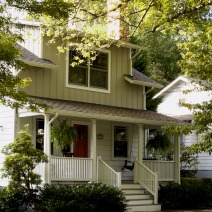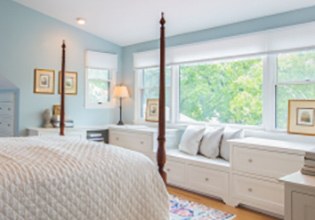Architectural Styles
There are homes with many different architectural styles, especially here in the Washington, DC metropolitan area. At Wentworth, we have experience remodeling and building additions to homes of all historic styles in many of DC’s historic districts, such as Capitol Hill, Georgetown, Kalorama, Cleveland Park, and more.
Read more about the different architectural styles on our blog »
American Bungalow
Although the term refers to structures built by the British in India, American Bungalow architecture and designs are in the “craftsman” style developed by the Greene brothers of Pasadena, CA.
Art Deco
A creative but short-lived movement, Art Deco not only influenced the architecture of most American cities but had an impact on fashion, art, and furniture, too.
Colonial Revival
Colonial Revival is the single most popular architectural style in the United States, in great part because of its richly varied vocabulary and inherent eloquence.
Federal
Having evolved from Georgian, the Federal (or Adam) style dominated the American architectural landscape from about 1780 to 1840.
Georgian
The Georgian style is admired for its symmetrical design, classic proportions, and decorative elements. The best remaining examples of this original architecture are in eastern seaboard cities such as Annapolis and Williamsburg.
Greek Revival
Greek Revival, which flourished from 1830 to 1850, is a great example of a style that gained popularity by exploring parallels between an earlier culture and the present day.
Italianate
Often included in the Picturesque Movement, the Italianate style began in England as a reaction to formal classical ideals that had dominated 19th century architecture.
Queen Anne
The style was popularized by a group of 19th century English architects—it inaccurately implies aesthetic ideas from the reign of Queen Anne (1702 – 1714).
Richardsonian Romanesque
Considered very modern in the mid-19th century, this architectural style imitated French building fashions of the period and is named after architect Henry Hobson Richardson.
Second Empire
The Second Empire architectural style can be traced to France, specifically to the reign of Napoleon III, 1852 – 1870.
Shingle
Like stick and spindlework Queen Anne, the Shingle style presents a uniquely American adaptation of other traditions—it appeared on the American scene between 1880 and 1900.
Stick
Stick is a transitional architectural style which links the preceding Gothic Revival with the subsequent Queen Anne. It was the most expressive style of a building’s underlying structure.
Tudor
From 1890 to 1940, some American homes were built based on a medley of late Medieval and early Renaissance styles. Homes with these distinguishing characteristics were classified as “Tudor.”








